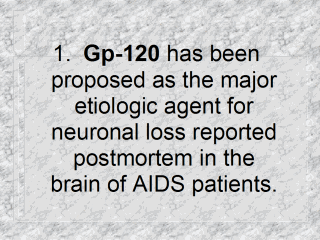 |
o infect target
cells, the human immunodeficiency virus (HIV) type I (HIV-1) must engage not
only the well-known CD4 molecule, but it also requires one of several
recently described coreceptors. In particular, the CXCR4 (LESTR/fusin)
receptor allows fusion and entry of T-tropic strains of HIV, whereas CCR5 is
the major coreceptor used by primary HIV-1 strains that infect macrophages
and CD4(+) T-helper cells (M-tropic viruses). In addition, the alpha
chemokine SDF1alpha and the beta chemokines MIP1alpha, MIP1beta, and RANTES,
natural ligands of CXCR4 and CCR5, respectively, are potent soluble
inhibitors of HIV infection by blocking the binding between the viral
envelope glycoprotein gp120 and the coreceptors. Approximately two-thirds of
individuals with acquired immunodeficiency syndrome (AIDS) show neurologic
complications, which are referred to a syndrome called AIDS dementia complex
or HIV-1-associated cognitive/motor complex. The HIV-1 coat glycoprotein
gp120 has been proposed as the major etiologic agent for neuronal damage,
mediating both direct and indirect effects on the CNS. Furthermore, recent
findings showing the presence of chemokine receptors on the surface of
different cell types resident in the CNS raise the possibility that the
association of gp120 with these receptors may contribute to the pathogenesis
of neurological dysfunction. Here, we address the possible role of alpha and
beta chemokines in inhibiting gp120-mediated neurotoxicity using the human
neuroblastoma CHP100 cell line as an experimental model. We have previously
shown that, in CHP100 cells, picomolar concentrations of gp120 produce a
significant increase in cell death, which seems to proceed through a Ca(2+)
- and NMDA receptor-dependent cascade. In this study, we gained insight into
the mechanism(s) of neurotoxicity elicited by the viral glycoprotein. We
found that CHP100 cells constitutively express both CXCR4 and CCR5 receptors
and that stimulation with phorbol 12-myristate 13-acetate down-regulates
their expression, thus preventing gp120-induced cell death. Furthermore, all
the natural ligands of these receptors exerted protective effects against
gp120-mediated neuronal damage, although with different efficiencies. These
findings, together with our previous reports, suggest that the neuronal
injury observed in HIV-1 infection could be due to direct (or indirect)
interactions between the viral protein gp120 and chemokine and/or NMDA
receptors.
www.biochemj.org/bj/333/0045/3330045.pdf |
